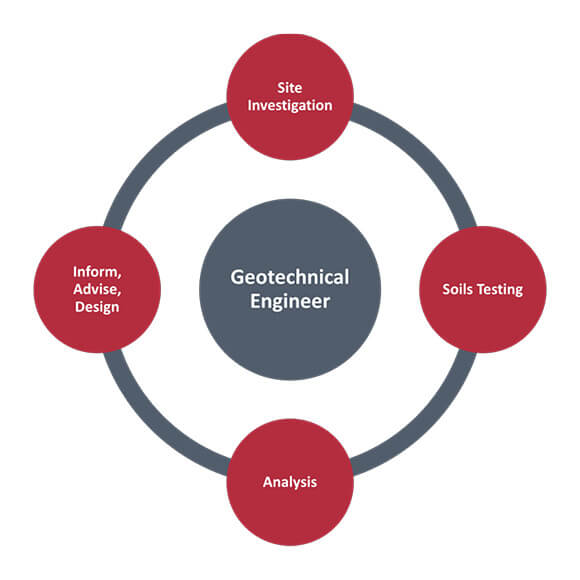Getting The Geotheta To Work
Table of Contents3 Simple Techniques For GeothetaNot known Incorrect Statements About Geotheta How Geotheta can Save You Time, Stress, and Money.The Geotheta Ideas
They team up with civil designers, structural engineers, architects, and various other specialists to integrate geotechnical considerations into the general task style and building process. This calls for reliable team effort, sychronisation, and communication to guarantee that the geotechnical elements line up with the project goals and meet regulatory demands.Mining & Materials Design: Concepts of boring, penetration rates, and factors influencing the option of drilling technique. Features of dynamites, shooting systems and blast patterns. Blasting strategies in surface and underground operations. Special blasting strategies at excavation perimeters. Resonance and sound control. Mechanical and continuous techniques to fragmentation, including longwall shearing and fullface boring.
Modelling of fragment and fragment dimension distributions; comminution as a transfer feature. Comminution modern technology: squashing, grinding, dimension classification. Integrated analysis of fragmentation and comminution operations. Offered by: Mining & Products Design.
Geotheta Fundamentals Explained
Bachelor's degree programs in civil, geotechnical, geological, and environmental design normally last 4 years and include basic education programs in English, social scientific research, and the humanities, as well as programs in sophisticated mathematics, structural geology, and fluid mineralogy. (https://www.anyflip.com/homepage/zuylo)
Geotechnical design entails the assessment of the dirt and rock problems at a particular website, and their implications for the advancement of that site. As many frameworks count on the ground for assistance, it lacks shock that a comprehensive understanding of the ground conditions, and the viability of foundation systems, are vital to the long-lasting security and performance of the building or structure.
Specialising in the examination of geological developments and ground practices, geotechnical engineers execute clinical examinations and screening to recognize the impact these geological formations might have on the layout and construction of building, civil and infrastructure projects. This knowledge is important for the style and building of buildings, roads, passages, dams, bridges, and water supply and sewer systems.
The geotechnical group at Douglas Allies routinely speak with engineers, layout engineers, developers, and home builders to make suggestions on style and development proposals to ensure that the constructed frameworks are appropriately designed for the ground conditions. The style of footing systems needs to think about the weight of the framework, the capacity of the ground to sustain that weight with each other with movement resistances and effective construction.
Geotheta Can Be Fun For Anyone
This task is greatly simplified by the usage of our Douglas Map geospatial system which makes this information conveniently available in a very easy to utilize internet browser user interface. A geotechnical designer will route the boring of boreholes and examination pits to accumulate soil and various other samples, and additionally examine surface area features and ground exposures to create a geotechnical model of the subsurface problems.
Depending on the job type and ground problems came across, laboratory testing might among other points analyze stamina, compressibility, reactivity and/or permeability of soil and rock examples. Hereafter data is accumulated and looked at, the results are utilized for a geotechnical version of the website, which is normally presented as areas throughout the website.

A geotechnical examination naturally can just evaluate the ground problems at the areas pierced or dug deep into. All-natural variants in dirt and rock problems can take place throughout a site and between examination places. It is as a result excellent technique that the geotechnical engineer be kept throughout construction of the job to give on-site confirmation that the ground conditions come across follow the assumptions and guidance given in the geotechnical investigation record.
3 Easy Facts About Geotheta Explained
Geotechnical engineers utilize their comprehensive understanding of soil and rock to examine threat and address troubles on diverse infrastructure projectsGeotechnical engineering is a specialist branch of civil engineering which looks at the behavior of planet products and the application of soil and rock technicians. Consulting Engineers. As a geotechnical engineer, you will analyze the physical, mechanical and chemical properties of dirt and rock in order to create structures, maintaining frameworks and earthworks
Geotechnical design is closely linked to and overlaps with, both engineering geology and ground design - https://geotheta.weebly.com/. It's feasible to specialise in geotechnics or job for a geotechnical company yet be called an engineering rock hound or a ground engineer. As a geotechnical engineer, you'll require to: develop and preserve relationships with clients and various other professionals involved in the site, throughout each projectmaintain safety and security criteria on website be mindful of expense effects when you make recommendationsstudy geological maps and aerial photographs from an array of sources and from various time periodsexamine building plans to see exactly how practical they are based on your understanding of the siteinvestigate threats or geological hazards for the sitesearch for her explanation eco sensitive functions, such as landfill beginning to create valid and expository ground modelsplan field investigationsdrill and analyse examples of bedrock, dirt, groundwater and additional materials manage various other specialists on sitesolve technical issues as they occur, such as unanticipated structures at drill sitesmonitor problems during and after building to make certain structures are steady in the short and lengthy termadding information accumulated on site to your first researchcreating geotechnical estimations, drawings, and 2 or three-dimensional computer system models interpreting the datamaking suggestions concerning the suggested use the website
